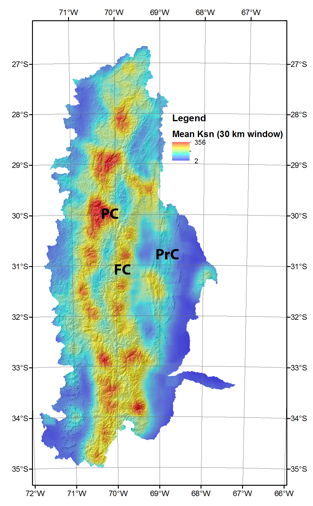Reports: DNI852480-DNI8: Evaluating the Mechanisms for Episodic Filling and Erosion in Wedge-Top and Proximal Foreland Environments in the Precordillera, San Juan Province, Argentina
Gregory D. Hoke, PhD, Syracuse University
Doctoral student Val has completed two field seasons in the Iglesia and Bermejo basins both of which were focused on sampling for Be-10 derived paleoerosion and establishing a chronologic framework for the perched sedimentary fill at the northern end of the Iglesia basin. Hoke and Val established a relationship with scientists at the German Center for Geoscience Research (GFZ), in Potsdam, Germany, where Val prepared samples for Be-10 cosmogenic nuclide analysis at the AMS facility if Cologne, Germany. Hoke and Val are now working on interpreting the Be-10 results in the context of paleoerosion rates. In addition to the paleoerosion rates, there are surface exposure age determinations for two key geomorphic markers within the Iglesia/Bermejo study area. Val has been deeply engaged in modeling various climate and tectonic end-member scenarios for the coupled basins using CHILD (Tucker and Hancock, 2012) and Fastscapes (Braun and Willett, 2013) landscape modeling software. Furthermore, Val has applied stream power-based determinations of channel steepness to identify the parts of the Andes that are currently experiencing rock uplift. His analysis reveals previously unidentified hotspots of active rock uplift in the Frontal Cordillera, as well as hotspots of rock uplift in the Precordillera (Fig. 1). Hoke and Val will prepare at least two manuscripts for scientific journals in the coming funding year.
Fig 1. Map of spatially smoothed normalized channel steepness indicies for the region between 27°S and 35°S. Warmer colors correspond to higher channel steepness values, and can be interpreted to reflect higher rock uplift. PC = Principal Cordillera, FC = Frontal Cordillera and PrC = Precordillera.
Despite a wealth of data western flanks of the Andes, low-temperature thermochronology data from the eastern flanks of the Andes are scarce with only three published studies (Hoke et al., 2014; Davila and Chemale, 2005; Coughlin et al. 1998). The overall perception is that thermochronology is hampered by low exhumation rates on the eastern flanks of the range (Thompson et al, 2010) and potentially exacerbated by low geothermal gradients (Collo et al. 2011; Davila and Carter 2013). Yet, thermochronology of the extensive Cenozoic foreland and intermontane basins could provide ample temporal and spatial insight into the development of the Andes as well as the magnitude of sediment flux to the foreland. Given the current state of knowledge, it makes tremendous sense to explore the sediment carried by modern rivers draining the mountain front before jumping into the rock record. McPhillips analyzed a total 160 zircons from 3 rivers for both U-Pb ages (at Boise State University) and (U-Th-Sm)/He (ZHe) ages using new laser ablation facility at Arizona State University. ZHe has a relatively high closure temperature that reflects a minimum of 5 km of exhumation under a standard continental geothermal gradient. Thus, if ZHe ages suggest exhumation, other lower temperature thermochronometers (apatite fission track or apatite (U-Th-Sm)/He) should also be sensitive. All three basins have a subset of grains with Cenozoic ZHe ages that are younger than U-Pb crystallization ages and suggest a level of exhumation previously unidentified on the eastern flanks of the Andes between 35 and 32°S latitude (Fig. 2). Furthermore, these results suggest the application of ZHe and other thermochronometers in the Neogene foreland basin sequences will yield substantial information regarding the development of the range.
Figure 2. Zircon U-Pb ages and (U-Th-SM)/He ages for the Rio Grande watershed near Manzano Historico, Argentina. Note Permian U-Pb ages show ZHe ages between crystallization and the late Miocene.













